I think we’re all familiar with the effect catnip has on kitties, but did you know that it’s edible and medicinal for humans? Catnip actually has the opposite effect on people that it has on cats.
Where felines get crazy hyper when they chew on the plant, it actually acts as a calming sedative in humans. It’s a very gentle and safe herb, even for babies.
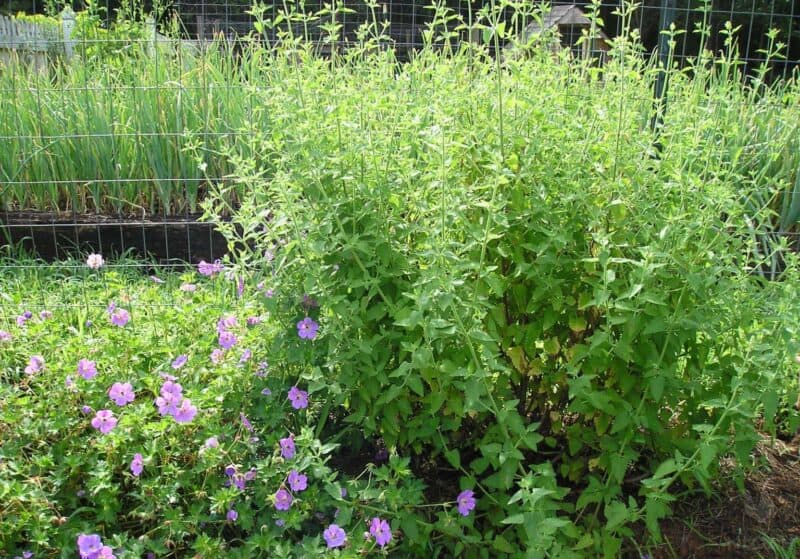
Table of Contents:
Varieties of Catnip
I used to think that catnip was catnip was catnip – I didn’t realize that not all catnip was alike! Although all types of catnip are relatively easy to grow and offer similar benefits, they aren’t all alike. Here are some of the differences.
So the most common catnip variety is Nepeta cataria. Also known as true catnip, this plant has been hybridized to create several offshoots of the original variety. Five popular types include, besides true catnip, Greek catnip, camphor catnip, lemon catnip, and Persian catmint.
Each of these produces flowers in varying colors (from white to purple and even light pink) and plants that grow to different sizes. The largest is lemon catnip or true catnip, both of which grow to more than three feet.
Most types of catnip have grey-green leaves that are shaped like hearts and are surrounded by delicate hairs.
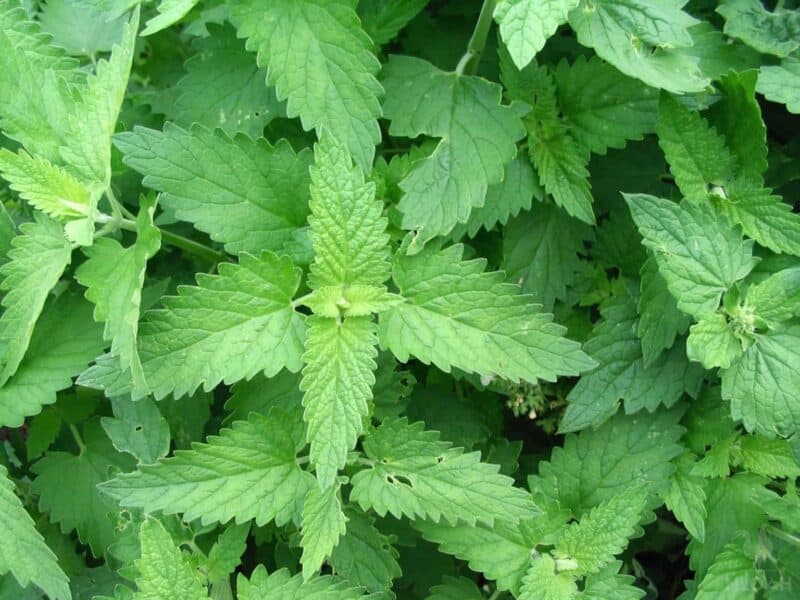
You can find other types of catnip, too, although those that we have already mentioned are the most common. There are different catnip plants from all over the world, including places like Japan, Pakistan, China, Crete, Spain, Portugal, and even the Himalayas.
Growing Catnip
When a good friend of mine dug up a little clump of her catnip plant and gave it to me a few years ago, I had no idea it would grow so well and spread so much. A member of the mint family, once you have it planted catnip is notorious for springing up all over the place.
This year our catnip decided to jump the garden fence and establish itself in several nice clusters in one of our garden beds. Boy did it make itself at home.
After witnessing a chorus of humming bees happily hovering all around the plants, I decided to let the catnip stay where it was since it was attracting so many beneficial pollinators to my other plants.
Catnip can be grown from seed, or purchased as a plant at a local or online nursery. They love full sun and thrive in good garden soil.
You can expect them to come back year after year, and spread where they may not be wanted. You can plant them in containers if you’d prefer that they stay in one place.
Here are some of the basics to growing it.
First, you need to know that if you are growing catnip from seed, you must first stratify them. In other words, you have to rough them up a little bit! This is because the exterior of the seed is very tough.
Luckily, the stratification process is pretty easy. All you need to do is place the seeds in the freezer overnight. Then, put them in a bowl of water for 24 hours. This will damage the seed coat, making it easier for the seeds to sprout.
Once you have stratified your seeds, you can plant them. Catnip grows best in well-draining soil (ideally in full sun) but it can tolerate a wide variety of soil types and even partial shade.
If you’ve ever grown mint, you already know how hardy plants in the mint family are. There’s not a lot that you need to do that’s special in order to grow these plants!
Just make sure you plant the seeds outdoors where they will have plenty of room to sprawl – this is a plant that really likes to take over.
You can plant catnip in either the spring or the fall (spring is recommended for seeds). If you are growing from started plants or from division, the choice is yours.
If you are seeding, you can just scatter the seeds loosely. Later, you will need to thin them one plant for every 20 inches. This is usually done after they have sprouted. If you are growing from seedlings, you will want to plant them 18 to 20 inches apart.
Once your plants are established, they will require very little in the way of care. You do not need to fertilize catnip and actually, it’s recommended that you don’t. fertilizer can not only hinder the growth of your catnip, but it can also reduce the flavor and scent of the plants.
Just give them a little bit of extra aster beyond regular rainfall. If you grow your catnip in pots, you will want to add extra water, as containers tend to dry out more easily.
In some places, catnip can be invasive. You will need to remove flowers before they go to seed in order to control its spread. Or you can just plant it somewhere that you don’t mind it spreading! That’s another option for you.
Problems With Growing Catnip
Catnip is a pretty hardy plant, and it’s adaptable to most soil conditions. In general, you can grow catnip just about anywhere, with the exception of soil that is too boggy or plots that receive too little light.
This plant has very few problems. Occasionally, catnip may suffer from cercospora. This disease is fungal-related and causes leaves to drop. Septoria leaf spot is another common fungal issue, common during rainy periods, as is root rot.
Generally, you can prevent fungal issues by thinking carefully bout the location in which you plant your catnip. Try to ensure proper spacing between plants too, to allow for maximum airflow.
There are also a couple of bacterial and viral disease to which catnip is prone. Bacterial leaf spot occurs, as you might have guessed, on the leaves of the plant. These spots are usually translucent and then darken with irregular red-colored centers.
Most common in cool, wet weather, the only way to prevent spreading this bacteria is to avoid working around them when they are wet. Sometimes, you may have to remove the infected plants.
As with most garden plants, practicing crop rotation is key. This will help prevent bacteria and viruses from being stored in the soil, and it will also help reduce the likelihood of pests overwinter in an area and affecting the same type of plant.
Using Catnip as a Companion Plant
Catnip looks a lot like mint, and it also has the beneficial characteristics of most mint plants, too. Therefore, catnip is an excellent companion plant in the garden. The oils found in catnip help to repel certain pests, keeping your vegetable and fruit plants healthier for longer.
When planted as a companion for various garden plants, catnip can be super beneficial. The oils in catnip have a tendency to repel pests like ants, aphids, Colorado potato beetles, flea beetles, cabbage loopers, cockroaches, squash bugs, Japanese beetles, and even weevils.
Therefore, by growing catnip alongside collards, pumpkin, broccoli, cauliflower, potatoes, squash, and beets, you can get rid of a lot of your pest-removal chores. Plus, the powerful scent of catnip is believed to have the ability to repel voles and mice, two other common garden pests.
After your garden has been harvested, you can even bring catnip indoors to repel pests. All you need to do is hang or sprinkle some wherever you don’t want pests to invade!
Protecting Your Catnip from Cats
So here’s the deal – if you’re planting catnip with the goal of attracting cats, then obviously, you can skip this section! However, if you’re growing catnip for medicinal or culinary uses for yourself, then you probably don’t want cats rolling around in it.
The other issue with catnip is that it can cause some digestive upset in your cats if too much is ingested.
If you find that cats are getting after your catnip plants too much, truly the only way to stop them is to erect some sort of a physical barrier.
You can use chicken wire or another type of wire fencing – just make sure the holes are large enough that the cat can’t get its body, head, or paws through the holes. You can also plant your catnip in a hanging basket, but make sure it’s out of the reach of your feline friend.
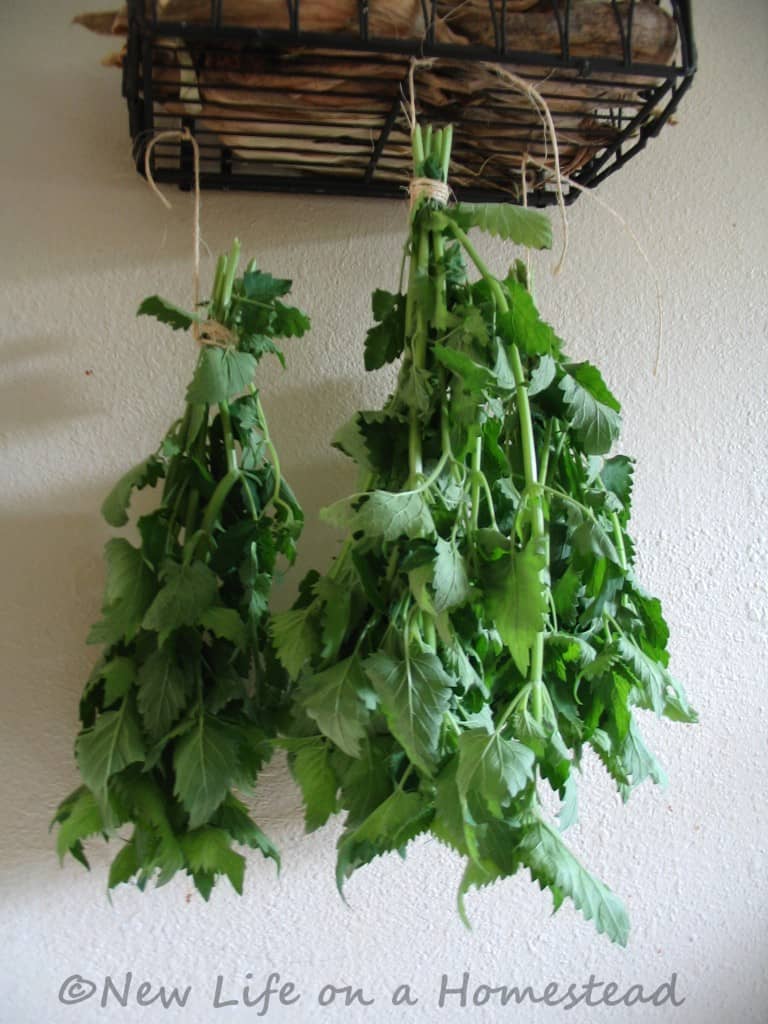
Harvesting and Drying Catnip
I like to harvest catnip just before it blossoms, or as it’s just beginning to blossom. Cut the stems a few inches from the base of the plant so that you don’t kill it. I usually leave about 6″ on the plant, just to be safe. Often, you can harvest catnip at least twice each year.
To dry catnip, you can hang it or place it in a dehydrator. I prefer to hang mine indoors until it crumbles to touch. If you live in an area with low-humidity, drying in the sun is another great option, just be sure to bring the herbs in overnight to avoid the moisture of dew.
Catnip is relatively winter hardy. It has high cold tolerance and grows well in zones three to nine. It is perennial and usually survives winter even with little protection.
If you’re concerned about the upcoming winter, you can prepare it by trimming it back in the fall. Cut the stems to a few inches and trim any ne growth so it doesn’t become damaged in the cold. You don’t need to water all winter.
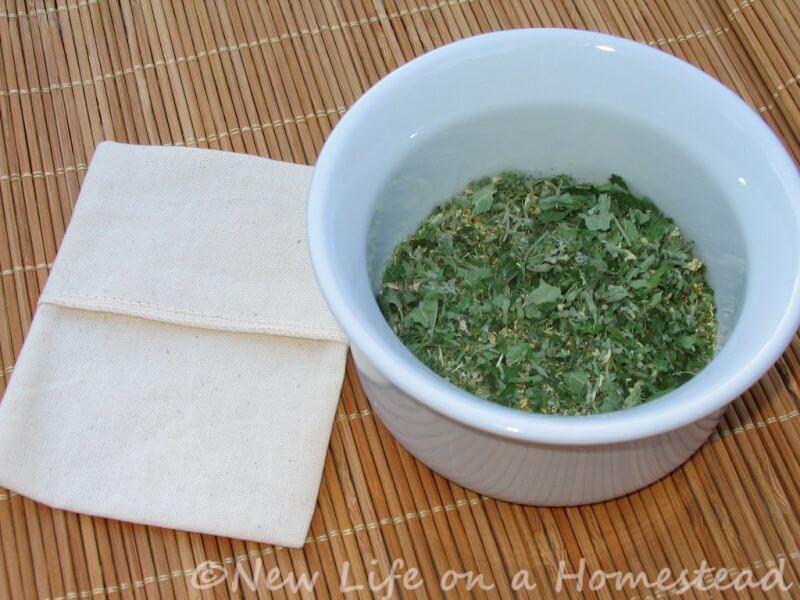
How To Use Catnip
Anytime you want to settle down, de-stress, relax your body and muscles, calm your nerves, ease restlessness, or fight insomnia, catnip tea is great for all of the above. For children, catnip is wonderful for treating colic, teething, hyperactivity, ADHD, or trouble getting to sleep.
Catnip by itself doesn’t have the greatest flavor, so I always try to add other calming and more flavorful herbs. My favorite blend for a soothing and delicious catnip tea includes chamomile and lemon balm. It also blends well with lavender.
Mix the following dried herbs together for a relaxing effect:
- 1 part Chamomile
- 2 parts Catnip
- 1 part Lemon Balm
Store in an airtight container (glass or plastic). To use, add 1 tsp herb blend to 1 cup hot water. Allow to steep for 15-20 min. (the longer the more medicinal), then sweeten with honey to taste. If you don’t have an infusion tea pot, be sure to cover the cup of hot tea with a cloth as it steeps to retain the essential oils in the herbs.
Catnip is great for teething babies. Make a batch of the tea mentioned above and freeze it into ice cubes or soak a washcloth in the cooled tea and freeze.
Allow your baby to chew on the frozen cloth to soothe their sore gums, or put an herbal ice cube in one of those mesh baby food feeders so that he can suck on the cube without choking. (Remember not to give honey to babies under a year old.)
Catnip is a potent mosquito repellant. Plant it around your home to keep mosquitoes away.
To ease muscle pain and relax your body, brew a 1/2 gallon batch of catnip tea using a few handfuls of fresh leaves or about a cup of dried catnip (lavender and chamomile added are nice as well), allow it to steep for 1-2 hours, strain it off and pour it into a hot bath to soak in.
Fresh catnip leaves can be eaten in salads or just nibbled off the plant. But the flavor is strong, kinda like mint, so use it sparingly.
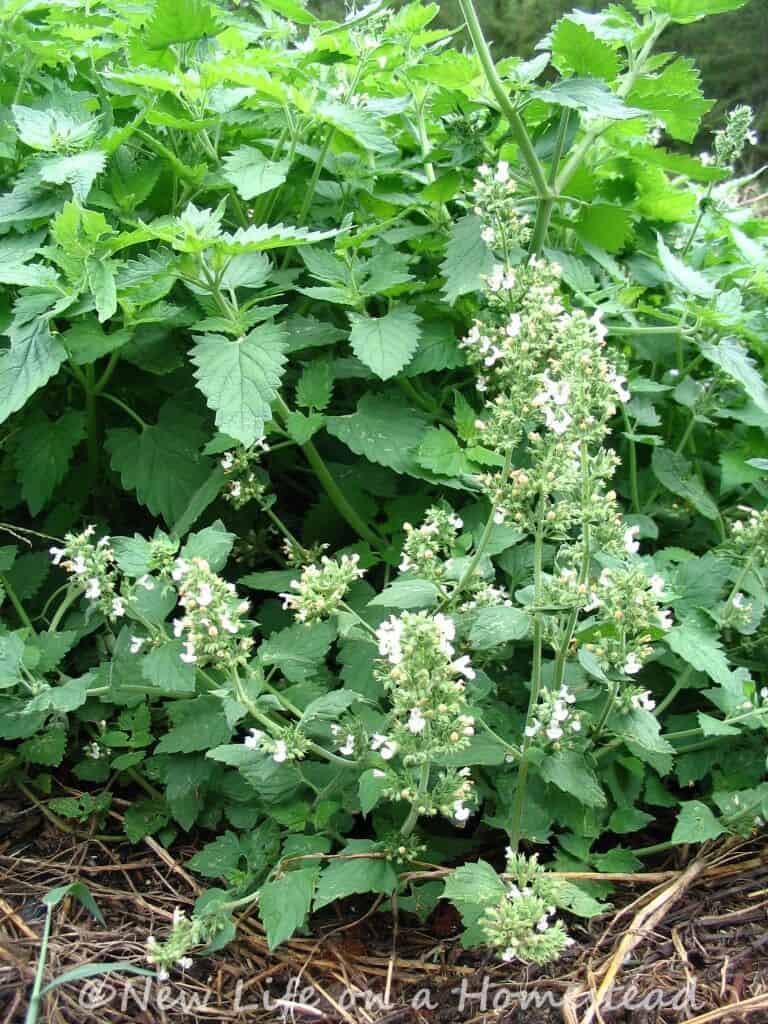
If you’re interested in treating your family with herbs, catnip would make a beautiful and useful addition to your flower bed or herb garden.
Do you have catnip growing? What’s your favorite way to use it?

A city girl learning to homestead on an acre of land in the country. Wife and homeschooling mother of four. Enjoying life, and everything that has to do with self sufficient living.

I love catnip in my yard but I’ve never tried it myself. As someone said, it’s one of the first plants up in the spring and the cats adore it. It spreads but it’s easy to transplant or just pull up and the BEES LOVE IT. Both catnip and catmint seems to be around when other bee friendly plants are at a lull. I’ve always just let it flower. Side note, some goldfinches seem to like the catnip seeds as well.
My grandma used to have catnip on her garden. When i was younger, i used to randomly eat some of the leaves until i had bellyache. I was a weird kid
Great information about catnip! I wonder, if I eat catnip would it keep mosquitos away from me? (They do love me.)
Thank you.
I cut the leaves up with scissors in my omelet for breakfast, along with dandelions, plantains, parsley, and chickweed. Add a few sage leaves, also cut up with scissors, okra, cauliflower, diced broccoli, chopped onion, a few grapes and two eggs, makes a wonderful omelet. Eat on soft tortillas like a taco. Keep you going until suppertime.
And the most important part, cook in a skillet with olive oil until all the veggies are tender.
We g have a ton of catnip growing wild on the prairie right by our house. An herbalist friend told me that the plant itself while growing doesn’t attract kitties, only when the leaves are bruised does the plant attract them. I have found this to be true, as they mostly ignore the growing plants but go absolutely NUTS when I harvest and process the plants/leaves. I had a good batch this season. Another interesting factoid, many herbalists swear by harvesting catnip and other medicinal plants on the Solstice day, believing the plants are at their peak of potency on that day. This is about when they begin to flower so it’s a good guideline.
I have a potbelly pig. Can I give catnip to her without concern??
I’m really not sure if/how catnip would affect a pig.
I have berries growing on some of my catnip. They are turning purple. Are edible?
they are supposed to be both delicious, and edible, according to my research
i found catnip growing by my porch steps. yuck! so bitter!
Hey! So I’ve just harvested my first batch of catnip. It’s ready to be broken up and or in oil. Did you cut yours down or out it in a food processor? The stems are so strong! Im having a difficult time cutting the stems down. Do you even put the stems in? Haha I’m new to this!!
It’s great to find soenome so on the ball
I just made some fresh tea from fresh leaves, and I can’t believe that I’ve wasted all these years not knowing I could drink it, let alone all the other purposes for it. When we had barn cats, they used to eat it, so I never plucked it out like a weed which is what it looks like. It has migrated here and there around our yard, and it just found a perfect spot in my asparagus patch where it will stay protected now.
Catnip is one of the first herbs to come up in the spring at our place. The cats love it but I’ve never harvested it before. This year, I will!
I’m sure the cats will be most disappointed that you’re stealing from their stash!
I had great results for several years at my old place (A townhouse in an under-construction development).
I had a big problem with feral and semi-feral cats ripping up trash and using my bird-feeders as cat-feeders. I went down to the opposite end of the neighborhood (never did get built on..), forked up a big patch, added compost and seeded heavily with catnip one spring. Still got the occasional possum, but the cats were busy elsewhere 🙂
LOL, Wyzyrd. Great idea!